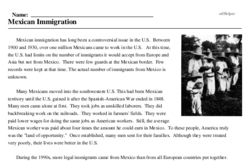Mexican Immigration
Mexican immigration has long been a controversial issue in the U.S. Between 1900 and 1930, over one million Mexicans came to work in the U.S. At this time, the U.S. had limits on the number of immigrants it would accept from Europe and Asia but not from Mexico. There were few guards at the Mexican border. Few records were kept at that time. The actual number of immigrants from Mexico is unknown.
Many Mexicans moved into the southwestern U.S. This had been Mexican territory until the U.S. gained it after the Spanish-American War ended in 1848. Many men came alone at first. They took jobs as unskilled laborers. They did backbreaking work on the railroads. They worked in farmers' fields. They were paid lower wages for doing the same jobs as American workers. Still, the average Mexican worker was paid about four times the amount he could earn in Mexico. To these people, America truly was the "land of opportunity." Once established, many men sent for their families. Although they were treated very poorly, their lives were better in the U.S.
During the 1990s, more legal immigrants came from Mexico than from all European countries put together. Mexican immigration continues today. It is estimated there are more than twenty million Mexican-born people living in the U.S. today. The actual number may be much higher.




